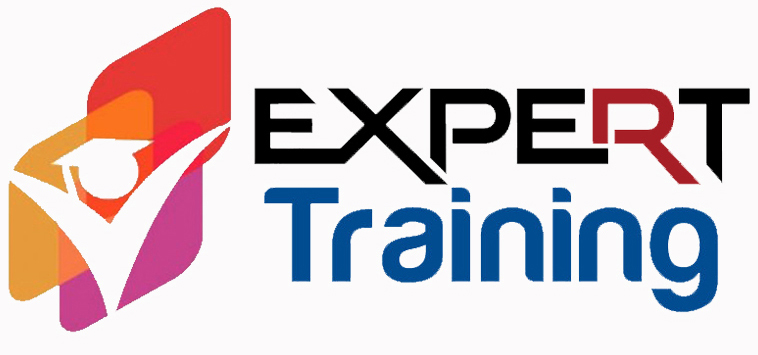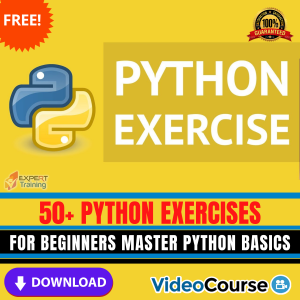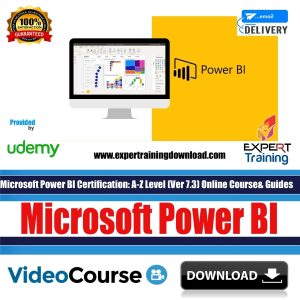Description
Price: 15.00 USD | Size: 12.9 GB | Duration : 33.59 Hours | 280 Video Lessons |
BRAND: Expert TRAINING | ENGLISH | INSTANT DOWNLOAD | 



 4.9
4.9
Arduino Step by Step Getting Started
No prior knowledge of electronics or programming required.
This classic course will teach you everything you need to know to create Arduino gadgets with sensors, displays, and lights.
We updated this course to cover the latest developments in the Arduino ecosystem, including the new Arduino IDE 2.0, and modern Arduino boards & kits.
We have added new lectures, updated original lectures, verified and fixed all links to online resources, updated all quizes, and embedded circuit schematics and the Arduino Web editor in all experiment lectures.
In making this course, I emphasized the importance of getting the basics right and learning to mastery. As an educator for over 15 years, I know first-hand that hitting a roadblock because you lack the fundamental knowledge to progress can be demotivating.
In Arduino Step by Step: Getting Started, through more than 18 hours of video content, mini projects and quizzes, you will cover all the basics so that you can enjoy learning about the Arduino.
Go hands-on with the Arduino’s inputs and output, learn about communications, and understand the differences between the Uno and some of the other Arduinos, like the Mega, Due, and the Zero.
In the last update of October 2022, we added lectures on the modern Arduino MKR and Nano families of boards.
Apart from knowing how to use the components that I demonstrate in this course, you will also learn how to read datasheets, how to use libraries on your own, and how to learn the skills you need to create the gadgets you want, on your own.
Learn about prototyping, how to use the multimeter, how to solder.
Go hands-on with the Arduino’s inputs and output, learn about communications, and understand the differences between the Uno and some of the other Arduinos, like the Mega, Due, and the Zero.
Arduino Step by Step Getting Started is also available as a Bootcamp for Teachers and Trainers.
In this Bootcamp, I help students to learn the curriculum to mastery so that they can go on to teach their students. The workload is intense, and the daily learning curve is steep.
In this Bootcamp, my role is to be a dedicated coach, and help the student one-on-one.
The Bootcamp version of this course costs US$997.
Within a month, a student that started from having no knowledge of the Arduino, graduates to be a confident maker, and teacher.
The transformation is impressive. That’s why I think that $997 for this Bootcamp is a steal.
But, a $997 Bootcamp is not for everyone.
If you prefer to learn on your own, then Arduino Step by Step Getting Started will save you hundreds of dollars compared to the Bootcamp.
It really is a bargain!
Apart from knowing how to use the components that I demonstrate in this course, you will also learn how to read datasheets, how to use libraries on your own, and how to learn the skills you need to create the gadgets you want, on your own.
Learn about prototyping, how to use the multimeter, how to solder.
What’s in this course?
Introduction to the course
What is this course about?
Tools you will need
Parts you will need
How to get the most out of this course
Update 2022 brief
Know your Arduino
Introduction
Getting to know the Arduino Uno: Atmega328P, USB, Shields
Getting to know the Arduino Uno: Pins, power, clock
Using the digital output pins
Using the digital input pins
Using the analog output pins
Using the analog input pins
Quiz
Introduction to communications
Introduction
Serial (UART) communications
I²C (TWI) communications
SPI communications
Quiz
Arduino boards
Introduction
Arduinos past and present
Classic Arduinos
Meet some members of the Arduino family
Introducing the Arduino Mega 2560
Introducing the Arduino Due
Introducing the Arduino Zero
Introducing the Arduino 101
Introducing the Arduino Pro Mini
Introducing Arduino-compatible boards
Modern Arduinos
Arduino MKR
Arduino Nano
Kits
Arduino Student Kit
Arduino Explore IoT Kit
Seeed Studio Arduino Sensor Kit
DFRobot Beginner Kit for Arduino
Quiz
Prototyping basics
Introduction
Using the breadboard
Using jumper wires
The absolutely essential tools
Powering your Arduino with power supplies
Using the multimeter to measure voltage
Using the multimeter to measure current
The multimeter – Resistance and continuity
The Arduino Student Kit multimeter
Introduction to soldering – the soldering iron
Soldering – preparation and using holders
Soldering – using wire cutters and fume extractor
Soldering – Simple maintenance tips for your solder iron
A demonstration of soldering a header onto a breakout board
An introduction to protoboards
Quiz
The Arduino IDE
Introduction
Arduino IDE 1.8
Arduino IDE 2.0
Arduino Web IDE
An introduction to the Arduino IDE
Getting and installing the Arduino IDE
Understand the basic parts of an Arduino sketch
The Arduino IDE – Understanding the Preferences pane
The Arduino IDE – Understanding the Menu items
How to upload a sketch to your Arduino
How to upload a sketch to your Arduino – For Windows users
Sharing code with the Arduino Web IDE
Quiz
Introduction to Arduino Programming
Introduction
An introduction to Arduino programming
Understand the basic parts of an Arduino sketch
Getting started with custom functions
Creating custom functions with parameters and the return keyword
Using variables
Understanding variable scope
Understanding constants
Introduction to control structures: The “if” statement
Introduction to control structures: The “while” statement
Introduction to control structures: The “For” statement
Introduction to control structures: The “Switch” statement
Digital output – how to control an LED
Digital input – how to read the state of a button
Analog input – how to read the state of a potentiometer
Analog output – how to create a fading LED
Introduction to the RGB (color) LED
Wiring the RGB LED
RGB LED: creating colors
Using a library to control an RGB LED with PWM
Learning more with the Arduino language documentation
Quiz
Arduino programming: Arrays
Introduction to this section
Introduction to Arrays
Arrays, Example 1
Arrays, Example 2
Arrays, Example 3
Arrays, Example 4
Quiz
Measuring light and color
Introduction
What is a photoresistor and how to wire it
How to select the appropriate fixed resistor for a photoresistor
Using the Ultra-Violet light sensor
An introduction to the RGB Color sensor
Wiring the RGB Color sensor
Mini project: copy a color to an RGB LED using an RGB Color sensor
Quiz
Measuring temperature, humidity and pressure
Introduction
Using a DHT22 sensor to measure temperature and humidity
An introduction to the Thermistor
Wiring the Thermistor
How to calculate the temperature from the thermistor resistance
Thermistor: getting a temperature using a library
Thermistor: improving the accuracy of analog readings with AREF
An introduction to measuring temperature with the TMP36
Wiring the TMP36 and a demonstration sketch
An alternate wiring of the TMP36
An introduction to the MCP9808 for very accurate temperature readings
MCP9808: Wiring
Using the MCP9808, demo and sketch walkthrough
MCP9808: A closer look at I2C addressing
An introduction to measuring barometric pressure with the BMP180
Wiring the BMP180 and first sketch walkthrough
A first demo sketch for the BMP180
A second demo sketch for the BMP180
Quiz
Detecting acceleration
Introduction
Introduction to detecting acceleration with the ADXL335
Wiring the ADXL335
Plugging the ADXL335 directly in the Arduino, and detect its orientation
Write the sketch for detecting orientation with the ADXL335
Quiz
Detecting objects with the infrared motion sensor
Introduction
Introduction to the Passive infra-Red (PIR) motion sensor
A simple PIR experiment with an LED
A demonstration of using the PIR sensor with the Arduino
PIR sensor first demonstration sketch walkthrough
PIR sensor second demonstration sketch walkthrough
Quiz
Sensing distance
Introduction
Introduction to the ultrasonic distance sensor
Wiring and understanding Trigger and Echo
How to calculate distance
Quiz
Sensing sound
Introduction
Introduction to the analog sound sensor
A demonstration and sketch of the analog sound sensor
A demonstration and sketch of the digital sound sensor
Quiz
Making noise with a buzzer
Introduction
Introduction to the buzzer
Playing music
Control the sound volume
Quiz
The Liquid Crystal Display
Introduction
Introduction to the LCD
LCD wiring in 4-bit parallel mode
LCD demonstration sketch
Display sensor data in the LCD
Connect LCD using the I2C adaptor
Using the RGB LCD and buttons shield
Quiz












Reviews
There are no reviews yet.